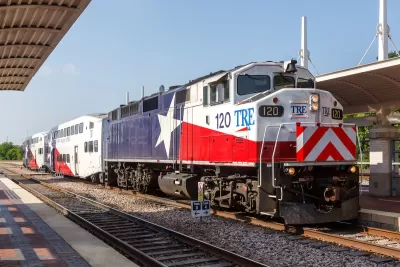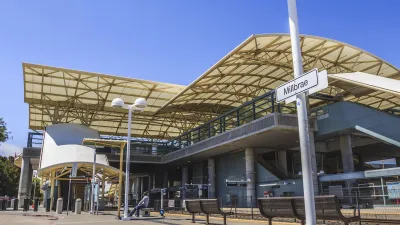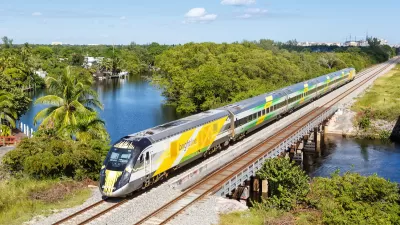An argument for why investing in trains is the key to sustainable growth and economic success in the Lone Star State.

In the vast expanse of the Lone Star State, a vision for a more sustainable and interconnected future is dominating the public stage: a vision that embraces the power of light rail as a catalyst for positive change.
As Texas grapples with urban sprawl, mounting traffic congestion, and environmental concerns, the call for increased funding for light rail projects resonates as a promising solution that transcends mere convenience. Let us embark on a journey through three pivotal themes, each underscoring the transformative potential of expanding light rail networks across Texas.
From fostering sustainable urbanization to facilitating a thriving ecosystem of freight services and manufacturing and enhancing long-distance travel options, this narrative uncovers how strategic investments in light rail infrastructure are poised to reduce emissions, alleviate road congestion, and revolutionize how we traverse this great state. In the context of a rapidly evolving transportation landscape, the case for bolstered funding for light rail initiatives in Texas becomes an imperative that transcends convenience and ushers in a future where sustainability, reduced emissions, and decreased road demand become the new norm.
While the vision of an expanded and interconnected light rail system across major Texas cities and metro areas promises a more sustainable and efficient future, it is evident that there remains much work to be done. Consider the case of Dallas and its Dallas Area Rapid Transit (DART) system. A vital component of the city's transportation infrastructure, DART currently has just one east-west light rail line—one that is still under construction, making it essentially non-existent. This glaring gap severely hinders the system's ability to provide comprehensive service, particularly in a sprawling metropolitan area like Dallas. Moreover, the considerable distance between stations outside downtown areas often fails to justify opting for light rail over personal vehicles, further impeding its potential to reduce road demand and emissions. A comparable situation unfolds in Austin, where the rail system, albeit efficient within its limited scope, consists of just one line insufficient to address the city's burgeoning transit needs effectively. With a public reluctant to rely on buses due to persistent traffic congestion, the urgency to enhance light rail and metro rail systems in these significant Texas cities becomes increasingly apparent. As climate change continues to loom as a pressing global issue, expanding and improving these rail networks becomes an essential step toward reducing emissions and promoting sustainable urban development.
Expanding and enhancing rail infrastructure in Texas holds the promise of transforming trade and manufacturing, significantly impacting the state's economy and its role in international commerce. The sheer magnitude of trade facilitated through Texas is staggering; in 2018, ports of entry within the state accounted for nearly $740 billion in international trade. Texas boasts 29 official ports of entry, each serving as a pivotal gateway to global commerce through airports, land ports, or seaports. These ports are integral to various domestic and international economic activities across multiple industries, making them linchpins in Texas’ transportation network. We can anticipate a multifaceted boon to trade and manufacturing by bolstering freight rail systems. First, it will foster increased manufacturing in Mexico, capitalizing on Texas’ status as the largest state exporter of goods in 2018, with Mexico being its largest market. Improved rail infrastructure will also mitigate the reliance on trucks, thus reducing traffic congestion, enhancing efficiency, and ultimately making cross-border trade, especially with Mexico, more cost-effective. Furthermore, Texas is the largest exporter of cotton in the United States, a distinction that improved rail networks can help maintain and expand. The correlation between robust rail systems and the promotion of trade and manufacturing cannot be overstated, underscoring the urgency of investing in this critical infrastructure.
Establishing a high-speed rail system connecting Houston and Dallas is not merely a visionary infrastructure project but a potentially transformative force with far-reaching benefits. In an era where climate change mitigation is paramount, such a rail system represents a sustainable alternative to the environmentally detrimental status quo. Approximately 24,300 people traverse the distance between these two major Texas cities daily by air or personal vehicles, contributing significantly to emissions and congestion. By embracing high-speed rail, we have the opportunity to make a substantial reduction in carbon emissions, ultimately limiting the impacts of climate change.
The advantages are not solely environmental. Commuters would enjoy an expedited and convenient mode of travel, spending less time in gridlock or security lines. Businesses can seize new growth opportunities, while local economies along the rail corridor stand to thrive, bolstered by increased trade and tourism. In essence, a Houston-Dallas high-speed rail system is the embodiment of sustainability, reduced emissions, and economic growth, a testament to the promise of a more interconnected, efficient, and ecologically responsible future for Texas and beyond.
The imperative to invest in expanded rail networks and high-speed rail systems across Texas emerges as an urgent call to action, predicated on the principles of sustainability, economic improvement, and enhanced quality of life for its citizens. The challenges posed by urban sprawl, traffic congestion, and environmental concerns underscore the pressing need for greater financial backing for light rail projects. Exploring the transformative potential of this endeavor, it becomes abundantly clear that the benefits extend far beyond mere convenience. Through the establishment of comprehensive rail networks, we can substantially reduce emissions, alleviate road congestion, and foster sustainable urbanization. By addressing these critical issues, we pave the way for a more interconnected and ecologically responsible future that enhances the well-being of Texas citizens and solidifies the state's role as a hub of trade, manufacturing, and international commerce. In the convergence of these goals, the true promise of improved rail systems shines brightly, offering a pathway to a more sustainable future for all Texans.
Mustafa Haque is a civil engineering student based in Texas. Haque is passionate about infrastructure and its role in promoting social justice and hopes to contribute to a better world through systematic changes in how we approach infrastructure creation and maintenance.

Trump Administration Could Effectively End Housing Voucher Program
Federal officials are eyeing major cuts to the Section 8 program that helps millions of low-income households pay rent.

Planetizen Federal Action Tracker
A weekly monitor of how Trump’s orders and actions are impacting planners and planning in America.

Ken Jennings Launches Transit Web Series
The Jeopardy champ wants you to ride public transit.

Rebuilding Smarter: How LA County Is Guiding Fire-Ravaged Communities Toward Resilience
Los Angeles County is leading a coordinated effort to help fire-impacted communities rebuild with resilience by providing recovery resources, promoting fire-wise design, and aligning reconstruction with broader sustainability and climate goals.

When Borders Blur: Regional Collaboration in Action
As regional challenges outgrow city boundaries, “When Borders Blur” explores how cross-jurisdictional collaboration can drive smarter, more resilient urban planning, sharing real-world lessons from thriving partnerships across North America.

Philadelphia Is Expanding its Network of Roundabouts
Roundabouts are widely shown to decrease traffic speed, reduce congestion, and improve efficiency.
Urban Design for Planners 1: Software Tools
This six-course series explores essential urban design concepts using open source software and equips planners with the tools they need to participate fully in the urban design process.
Planning for Universal Design
Learn the tools for implementing Universal Design in planning regulations.
Ada County Highway District
Clanton & Associates, Inc.
Jessamine County Fiscal Court
Institute for Housing and Urban Development Studies (IHS)
City of Grandview
Harvard GSD Executive Education
Toledo-Lucas County Plan Commissions
Salt Lake City
NYU Wagner Graduate School of Public Service





























